Harbinger of the Future
Had Gadya, the playful, threatening and ultimately reassuring song that ends many Seder evenings among Ashkenazi Jews, has a long history in the Haggada. It emerged from German folk songs to be first printed in the Prague Haggada of 1595. The classic commentators have equated the kid with the Jewish people and each succeeding animal as an oppressor of Israel from the cat representing Assyria to the Angel of Death representing the Turks. In the end the Holy One triumphs, thwarting death with the messianic redemption. Among the illustrious commentators are Jonathan Eybeschetz (1690-1764), the Vilna Gaon (1720-1797) and the Hatan Sofer (1762-1839). In the early twentieth century two artists, El Lissitzky and Menachem Birnbaum, provided contrasting interpretations. One artist looks back to find Jewish hope and the other peers darkly into the Jewish future.
El Lissitzky’s (1890-1941) Had Gadya is easily the most famous and frequently reproduced visualization of this song. He grew up in Vitebsk, Russia and after the 1917 revolution joined Chagall teaching in the Vitebsk art school. He was deeply involved in the movement to recreate Jewish culture in Russia especially in the publication and illustration of Yiddish books. This Had Gadya of color lithographs published in Kiev in 1919 was limited to seventy-five copies while a second edition in 1923 of one thousand was printed in black and white. Soon after the 1919 edition El Lissitzky turned his attention to the most radical modern art movement of the time, Constructivism. Along with fellow Russian Casimir Malevich, he created a totally abstract visual language, merging aspects of painting and architecture. The seeds of this new vision are clearly visible in Had Gadya.
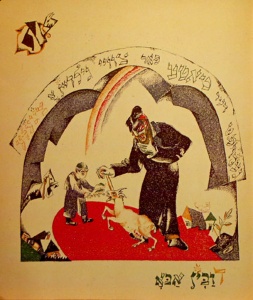
The first page, “My father bought…” exhibits the pattern that will repeat throughout. Each page is dedicated to one verse presented in Yiddish that is integrated into the architectural design arching over the main scene. The signature Aramaic phrase for the verse is creatively lettered at the bottom right to balance the elaborate pagination in the upper left. The lettering is frequently color coded with a character, such as the green word tateh corresponds with the green in the father’s face. On the first page a rainbow arches down from heaven with its promise of peace while the shtetl, the father, child and the goat reside innocently below. The ground is blood red.
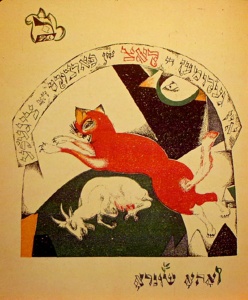
“Then came the cat” releases a savage fury of the red feline, claws and teeth bared, leaping over the slain goat. The background has broken up into a disjunctive abstract design. Brutal nature has taken over as Heaven looks on passively.
The dog cowers whimpering with its tail between its legs beneath the threatening stick. Mankind enters the narrative song violently as a rooster shaped fire (reflecting Yiddish slang for arson) devours the stick. The fire, erupting from the tops of the buildings, strongly suggests the shtetl and synagogue burning, a vision all too familiar to Russian Jews. Respite from the violence is seen on the sixth page as a giant fish spews water to smother the fire. The image echoes with Shabbos peace as the village water carrier reacts in awe to the supernatural effusion.
“Then came the ox” is seen on the seventh page, the most placid, kind and gentle red ox slowly lapping up water from a stream. Nature, domestication and the little shtetl are in complete harmony until the shochet enters next with his long slaughtering knife. He gestures Heavenward in explanation to the unprotesting ox, seeming to say, “It is all part of God’s plan…” Nonetheless the sky begins to darken.
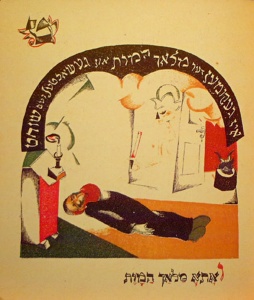
The Angel of Death haunts the vision of the dead shochet as the candle flame is about to be blown out. Death is sudden and shocking. Finally “Then came the Holy One” asserts God’s sovereignty and power. Death is destroyed, the goat and the man are revived and the All Seeing Eye rules brandishing a knife of power.
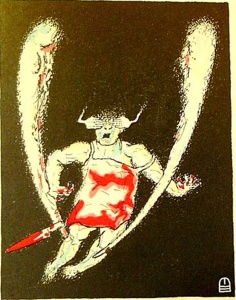
El Lissitzky has shaped the song into a traditional meditation on violence. In nature it erupts spontaneously, spiraling out of control until anti-Semitic mankind’s intervention can actually make it worse. Nonetheless the Jewish Sabbath and the fixed patterns of Jewish life tames the violence until we all succumb to the Angel of Death that will be finally vanquished by the Holy One. There are some interpretations that maintain that El Lissitzky meant to depict the new Soviet revolution as ultimate redeemer from death, but the symbols he allegedly used pale next to the power of the traditional interpretations. His thoroughly radical form points resolutely to Western modernism and not to reactionary Soviet art.
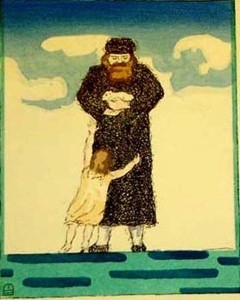
A very different vision of Had Gadya is seen in the hand-colored plates Menachem Birnbaum (1893-1944) created in 1920 Berlin. He was a portraitist and graphic artist, the son of Nathan Birnbaum, Zionist ideologue who originated the term “Zionism.” His work commences with a most beguiling image of a Chasidic father cradling a kid in his arms, his daughter reaching up to the helpless animal. Next the broad black form of the cat is seen from above mauling the helpless goat in a pool of blood. A vicious dog swings the tiny figure of the cat in a blood-splattered trajectory that amplifies the horror of violence.

Then an enormous cudgel bloodily smashes the dog with a savage force that seems to echo contemporary political violence. While there is a respite in the cooling rain that extinguishes the fire the violence begins again as the ox is mercilessly slaughtered by a grim faced shochet. In what might be the most shocking image of the series the Angel of Death claims his victim by simply covering his eyes from behind, his glistening wings and bony hands the only fatal instruments visible. With Birnbaum we have entered a terrible world of mindless violence and death, one that reflects the unrelenting brutality of the First World War. It is, in spite of his rather traditional representation, the Modern Age. Birnbaum’s images are graphic, spare and unrelenting. In the years that followed Birnbaum had some success working in two Jewish publishing houses but he was finally forced to flee by the Nazis. He was captured in Holland, deported and murdered in Auschwitz. His Had Gadya was prophetic.
Birnbaum’s work sees darkly into the future, wrenching a terribly modern meaning from the ancient song of the Haggada, allowing God to appear only as a shaft of light in the final darkness. El Lissitzky’s optimism is based on Jewish tradition and a secular revolutionary zeal that the Messianic age could be brought about by mankind. These two visions will haunt the ending of this year’s Seder and many to come.
Had Gadya: The Only Kid, illustrated by El Lissitzky (1919), facsimile published by Getty Research Institute. Editor, Arnold Band, Introduction, Nancy Perloff, 2004
Chad Gadjo, illustrated by Menachem Birnbaum (1920)
Courtesy Kestenbaum and Co. (January 27, 2004 Auction)